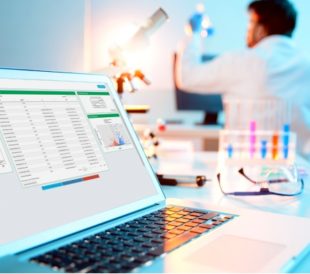
In recent years, the convergence of edge computing technology and artificial intelligence (AI) has opened up new opportunities for scientific organizations to enhance their data processing capabilities. This powerful combination, known as edge AI, is revolutionizing the way scientific data is collected, analyzed, and utilized. In this blog, we will explore what edge AI is, its increasing importance to scientific organizations, and how companies can prepare their data for its application. Additionally, we will highlight the role of Laboratory Information Management Systems (LIMS) with data analytics capabilities in enabling edge AI in the scientific domain.
Understanding Edge AI
Edge AI emerged as a result of advancements in both artificial intelligence (AI) and edge computing technology. The concept of edge computing, which involves performing data processing and analysis closer to the source of data generation, gained traction due to the increasing need for real-time analytics. Simultaneously, AI algorithms and models became more sophisticated and capable of running efficiently on resource-constrained devices, rather than relying solely on centralized cloud computing. By bringing AI capabilities closer to the source of data, edge AI reduces latency, enhances real-time decision-making, and alleviates the burden on network bandwidth. It enables devices and systems to perform intelligent tasks locally, without the need for constant connectivity to the cloud.
Instead of relying solely on centralized cloud computing for AI tasks, edge AI brings the power of AI algorithms directly to edge devices or local servers. This enhances privacy by keeping sensitive data within the local environment. Edge AI is used across various industries and domains, including but not limited to:
- Internet of Things (IoT): Edge AI is extensively used in IoT applications, where connected devices generate massive amounts of data. By performing AI tasks at the edge, IoT devices can process data locally, enabling real-time insights and faster response times.
- Autonomous vehicles: Edge AI is crucial for autonomous vehicles, allowing them to process sensor data in real-time to make decisions quickly. This is essential for tasks such as object recognition, lane detection, and collision avoidance.
- Healthcare: In the healthcare industry, edge AI enables real-time analysis of patient data, allowing for immediate diagnosis and treatment decisions. It also facilitates remote monitoring and personalized healthcare services.
- Manufacturing: Edge AI is employed in manufacturing environments to optimize production processes, monitor equipment health, and detect anomalies in real-time. This helps improve operational efficiency and reduce downtime.
- Surveillance and security: Edge AI is used in video surveillance systems to analyze video feeds in real-time, detecting and alerting for potential security threats or suspicious activities. This enables quick response and proactive security measures.
- Natural language processing: Edge AI is utilized in voice assistants and chatbots, enabling them to process and understand user queries locally, without relying on cloud connectivity. This enhances response time and privacy.
- Scientific and/or manufacturing organizations: Where data gathered from IoT devices, instruments, equipment and observations drives decisions around R&D or manufacturing, it’s imperative for the business to be able to quickly analyze and retrieve information that helps determine what adjustments need to be made.
The applications of edge AI are diverse and continue to expand as technology evolves. By bringing AI capabilities closer to the source of data generation, edge AI empowers industries to make faster, smarter decisions and unlocks new possibilities for real-time analytics and automation.
The Growing Importance of Edge AI in Scientific and Manufacturing Organizations
Scientific and manufacturing organizations, in industries such as food and beverage, oil and gas, chemical R&D and pharma and biopharma, are generating vast amounts of data from various sources, including sensors, instruments, and experiments. Traditional approaches to data processing often involve transferring this data to centralized servers or cloud platforms for analysis. However, in time-critical scientific research and large-scale manufacturing operations, this approach can pose challenges due to latency, bandwidth limitations, and privacy concerns.
Edge AI offers a solution by allowing such organizations to process and analyze data at the edge, closer to where it is generated. This capability enables real-time analysis, immediate insights, and rapid decision-making, crucial for time-sensitive experiments and critical production scenarios. Furthermore, edge AI reduces the reliance on constant network connectivity, making it ideal for remote or resource-constrained environments where cloud access may be limited.
Preparing Data for Edge AI Application
To leverage the benefits of edge AI, companies need to prepare their data appropriately. Here are some essential steps to consider:
- Data collection and integration: Ensure seamless integration of data from various sources, such as instruments, sensors, and experiments, into a centralized data repository. This step may involve implementing a robust LIMS that can capture and organize diverse data types.
- Data preprocessing: Cleanse and preprocess the data to remove noise, outliers, and inconsistencies. This step ensures the accuracy and reliability of the data for subsequent analysis.
- Data annotation and labeling: Labeling the data with relevant metadata and annotations facilitates efficient analysis and model training. Properly labeled data helps the AI algorithms understand the context and make accurate predictions.
- Model development and deployment: Train AI models using suitable algorithms on the prepared data. These models can then be deployed at the edge, either directly on edge devices or on local servers, allowing for real-time inference and analysis.

LIMS and Data Analytics in Enabling Edge AI
Laboratory Information Management Systems (LIMS) play a crucial role in enabling edge AI in the scientific domain. Modern LIMS solutions equipped with advanced data analytics capabilities provide a robust infrastructure for data storage, integration, and analysis. With LIMS, scientific organizations can leverage edge AI through:
- Real-time data processing: LIMS with data analytics capabilities bring real-time data processing and analysis closer to the edge, empowering scientists to make immediate decisions and respond swiftly to changing conditions.
- Data interpretation and insights: LIMS equipped with AI algorithms can interpret complex scientific data, uncover patterns, and generate valuable insights. This allows organizations to extract meaningful information from their data, leading to informed decision-making and improved research outcomes.
- Enhanced efficiency and productivity: By automating data analysis and interpretation, LIMS with edge AI capabilities streamline scientific workflows, reduce manual effort, and increase overall efficiency and productivity within scientific organizations.
Edge AI is rapidly transforming the scientific domain by enabling real-time analysis, immediate insights, and enhanced decision-making capabilities. Scientific organizations can prepare for its application by ensuring robust data collection, integration, preprocessing, and model development processes. Leveraging LIMS, such as Thermo Scientific SampleManager LIMS, with data analytics capabilities further empowers organizations to interpret their data effectively and make informed decisions. As edge computing technology and AI continue to evolve, embracing edge AI in the scientific domain will undoubtedly drive innovation and accelerate scientific breakthroughs.



Leave a Reply